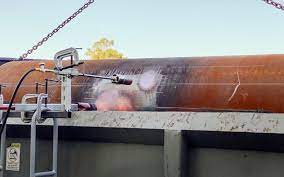3 min read
Handling Hard Spots: ADV's Hard Spots JIP Seeks Clarity in Hard Spots Threat Management
 Atul Ganpatye, PE
8/4/23 1:35 PM
Atul Ganpatye, PE
8/4/23 1:35 PM

The behavior of high hardness threats (hard spots) and the testing, inspection, and analysis process appropriate for identifying, treating, and monitoring hardness is a developing area of study. Operators are looking for answers to questions about the consequences of hard spots, how to detect and quantify these features, how to manage the potential associated threats, and what they should know for comprehensive integrity management.
Hardness at a High Level
Hard spots are created in pipeline steel from localized quenching during the manufacturing process. The steel microstructure transforms (partially) to martensite upon rapid cooling. Martensite is the hardest microstructure achievable in steel and martensite formation manifests as areas of high hardness in a pipe—also commonly referred to as “hard spots.” Areas of high material hardness increase the susceptibility of cracking in pipelines, especially in the presence of hydrogen.
For effective and efficient threat management due to hard spots, we need to start with understanding the “Why’s:”
- Why are hard spots an issue?
- Why have previous hard spots failures occurred?
- Why do we need to revisit the inspection methods and approaches?
Studying the “Why’s” paves the path for what we need to do and what approaches we need to take for a comprehensive solution. An ideal hard spots integrity management approach will need a systemic evaluation of many factors that span pipe susceptibility, including hard spot detection and quantification, in-the-ditch verification, and hydrogen exposure with associated degradation of mechanical properties—not to mention the other factors that we may not know yet!
Hard Spots and Swiss Cheese
Although there is absolutely no correlation between hard spots and “Swiss” and “Cheese,” the alignment of Swiss Cheese holes has been used in the engineering communities routinely to convey the concept of how accidents are triggered when the right set of causative factors align. In the context of hard spots, the Swiss Cheese model communicates that the mere presence of hard spots does not necessarily imply failure—it is when the causative factors align that the potential for failure arises.
The Swiss Cheese model also emphasizes the need for a systemic approach to hard spot integrity management. The potential for hard spots failure can be better interpreted when the individual contributing factors are studied and better understood. Knowing what factors increase the failure potential also allows for a better alignment and application of mitigation measures.
When all the factors of the Swiss Cheese model align, then a hard spot failure becomes possible. Improving the knowledge base for the described contributing factors will improve our understanding of hard spot failures and support mitigation efforts to stop failures.****
Small Steps, Big Impact
Thinking about the Swiss Cheese model (many small contributing factors leading to a failure potential) in a more positive sense, we could draw a parallel view that several small mitigation measures can lead to a big positive integrity management impact. So, while working together for a comprehensive hard spots threat solution, we should be on the lookout for continuous, incremental improvements using newer inspection technologies, verification methods, and an improved understanding of hard spot mechanics.
These incremental improvements—even if they feel like they are small when viewed in isolation—will almost certainly lead to better processes and procedures for hard spots evaluation that can be implemented immediately while broader integrity management plans are being developed.
Integrity Management of High Hardness Areas in Pipelines JIP
The Integrity Management of High Hardness Areas in Pipelines JIP facilitated by ADV Integrity will provide operators with several benefits using a 4-phased framework:
- Knowledge gathering, reviewing, and summarizing data to identify gaps in current hard spots management approaches.
- A comprehensive review of anonymized ILI data and hardness quantification procedures and in-the-ditch hardness measurement techniques and technology.
- Sub-scale and full-scale destructive testing to establish correlations between hardness values, metallurgical characteristics of high hardness areas, with mechanical performance.
- Development of a guidance document to integrate the findings of phases 1-3 for guidance on assessing and managing areas of high hardness.
Overall, the participants in the JIP will benefit from an improved understanding of prior hard spots incidents, recommendations for more precise and accurate ILI and in-field hardness quantification, and an integrated framework for managing hard spots in pipelines. Although the focus of the JIP is on what the industry has been traditionally referring to as “hard spots,” the use of the term “High Hardness Areas” broadens the field of study. Not all hard spots have the same cause, so broadening the scope to “high hardness areas” captures applicable threats not otherwise included.
Originally published on April 21, 2023

